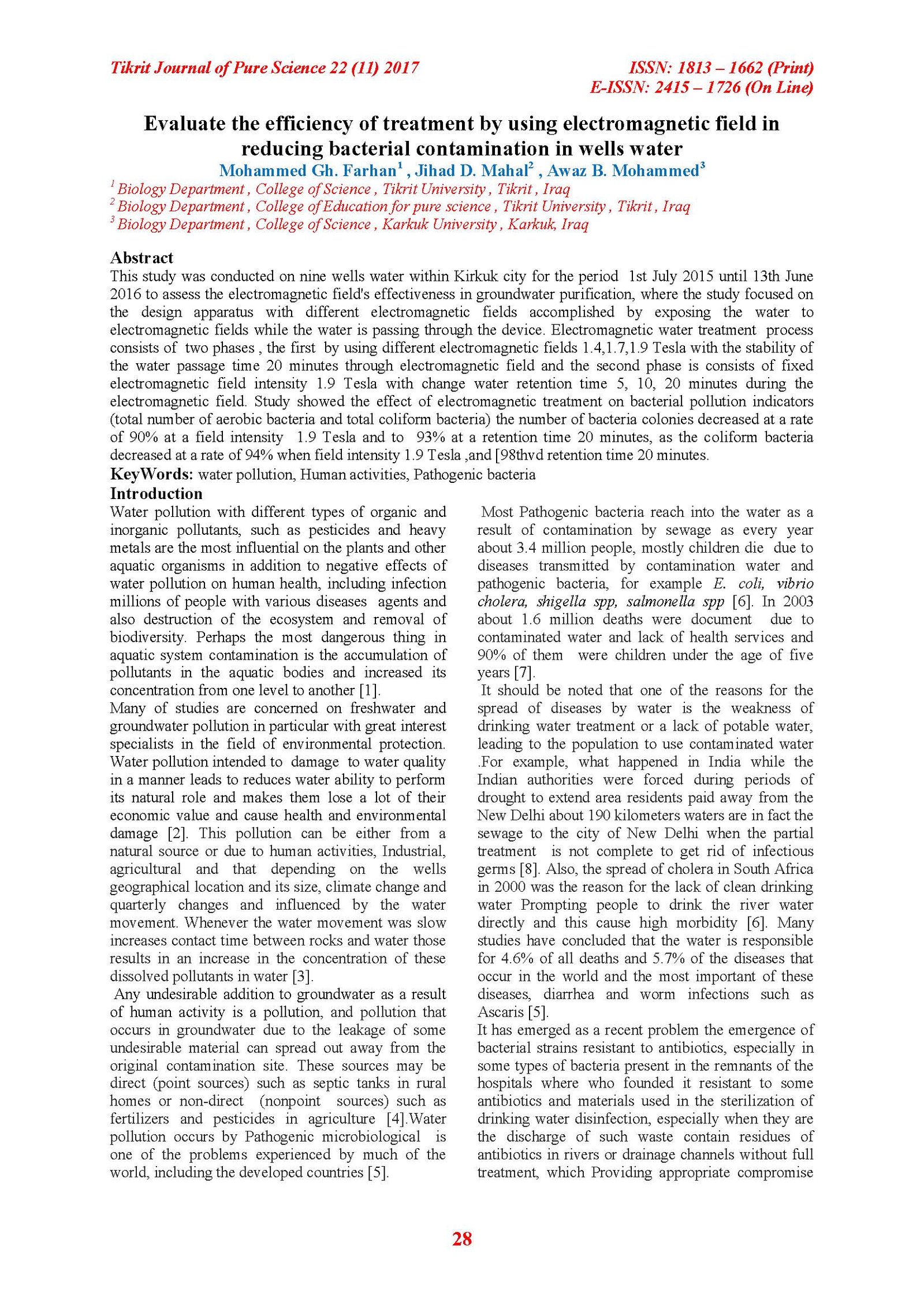Evaluate the efficiency of treatment by using electromagnetic field in reducing bacterial contamination in wells water
Main Article Content
Abstract
This study was conducted on nine wells water within Kirkuk city for the period 1st July 2015 until 13th June 2016 to assess the electromagnetic field's effectiveness in groundwater purification, where the study focused on the design apparatus with different electromagnetic fields accomplished by exposing the water to electromagnetic fields while the water is passing through the device. Electromagnetic water treatment process consists of two phases , the first by using different electromagnetic fields 1.4,1.7,1.9 Tesla with the stability of the water passage time 20 minutes through electromagnetic field and the second phase is consists of fixed electromagnetic field intensity 1.9 Tesla with change water retention time 5, 10, 20 minutes during the electromagnetic field. Study showed the effect of electromagnetic treatment on bacterial pollution indicators (total number of aerobic bacteria and total coliform bacteria) the number of bacteria colonies decreased at a rate of 90% at a field intensity 1.9 Tesla and to 93% at a retention time 20 minutes, as the coliform bacteria decreased at a rate of 94% when field intensity 1.9 Tesla ,and [98thvd retention time 20 minutes
Article Details

This work is licensed under a Creative Commons Attribution 4.0 International License.
Tikrit Journal of Pure Science is licensed under the Creative Commons Attribution 4.0 International License, which allows users to copy, create extracts, abstracts, and new works from the article, alter and revise the article, and make commercial use of the article (including reuse and/or resale of the article by commercial entities), provided the user gives appropriate credit (with a link to the formal publication through the relevant DOI), provides a link to the license, indicates if changes were made, and the licensor is not represented as endorsing the use made of the work. The authors hold the copyright for their published work on the Tikrit J. Pure Sci. website, while Tikrit J. Pure Sci. is responsible for appreciate citation of their work, which is released under CC-BY-4.0, enabling the unrestricted use, distribution, and reproduction of an article in any medium, provided that the original work is properly cited.
References
3-Vanden Broek, J.L.; Gledhill, K.S. & Morgan,
D.G. (2002) Heavy metal concentration in the
Mosquito fish, Gambusholbrooki, in the Manly
Lagoon Catchmen.
2- Taha, A.A.; El-Mohmoudi, A.S. & El-Haddad,
I.M. (2004). Pollution sources and related
environmental impacts in the New communities
southeast Nile Delta, Egypt. Emirates Journal for
Engineering Research, 9(1): 35-49.water from
slaughter houses. Zen Bac.17:269. Environmental
Geology, 40 (1-2) : 31-40.
3- Al-Salim, T.H. and Salih ,A.M.(2001). Ground
water quality atAl-Rasheedia and Gubaarea northwest
of Mosul city .Iraq. Raf. J. Sci. 12(4) :35-40.
4- Al-Khateeb, S. Ahmed (2004). Water pollution
and environmental pollution series second edition of
the Egyptian library for printing, publishing and
distribution. Egyp.
5- Pruss, A. Kay, D. Fewtrell, L. & Bartram, J.
(2002). Estimating the burden of disease from water
sanitation and Hygiene at a global level.
Environmental Health Perspectives 110(5):535-542.
6- World Health Organization (WHO). (2000)
water supply sanitation and Hygiene links to health
Geneva.
7- World Health Organization (WHO). (2004).
Guidelines for Drinking–water quality (3rded.)
Geneva
8- Amer, M. Amin & Suliman, M. Mahmoud
(2003). The environment pollution is problem of era,
The modern book house. Egypt.
9- Emanuel, E; Blanchard. J.M.; Keek. G;
Perrodin 8. Y. (2001) . Character isolationof hospital
swage in Baghdad city .Environ. Pollut.(ser.A).41:1-
108.
10- Al-Saadi, H. Ali. (2002). Ecology and pollutionthe
national library- Baghdad University (in Arabic).
11-Al-Mayahi S. F. Abd. (2008) Evaluated the main
drinking stations in some cities in the province of
Diwaniyah. Qadisiya Journal of Pure Science Volume
13 Issue 3 Page 89-
12- Coey, J.M.D., S., Cass, (2000) Magnetic water
treatment, Journal of Magnetism and Magnetic
Materials, 209, PP: 71-74.
13- (WHO) World Health Organization. (1996).
Guide line for drinking water quality
14- APHA(American Public Health Association)
(1999) . Standard Methods for the Examination of
Water and wastewater, 20th Edition A.P.H.A.1015
Fifteen Street, N.W. ,Washington DC.USA.
15- Hozayn, M. & Abdul qados, A. M.S. (2010).
Irrigation with magnetized water enhances growth,
chemical constituent and yield of chickpea.
Agriculture and Biology .Journal of North America,
ISSN on line : 2152- 7525.
16- Raichenko, I. O.; Mosienko, S. V.; Vladimir
Sh.; Derev’yanko, V. O.; Yanish, V. Y.;
Karnaushenko, V. O. (2011) Combined action of
low temperature and magnetic field of different
intensities on growth of some bacterial species in
vitro. Vol.4, No.4, 249-252..
